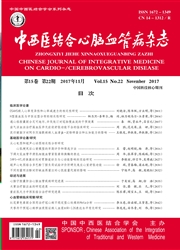

 中文摘要:
中文摘要:
目的观察以高脂饲料喂饲大鼠建立的高脂血症动物模型在学习记忆能力方面的动态变化,探讨痰浊血瘀动物模型向痰瘀阻窍证发展的规律。方法雄性SD大鼠,自由进食高脂饲料2周、4周、8周、16周后,采用Morris水迷宫和物体识别的实验方法检测模型大鼠学习记忆能力的时程变化特点。结果Morris水迷宫试验结果表明,与对照组比较,高脂饲料喂养4周起,大鼠的学习记忆能力明显下降,16周时最为显著,表现为逃避潜伏期延长,目标象限时间百分比减少。物体识别试验结果表明,高脂饲料喂养2周起,大鼠学习记忆能力有所下降,8周起下降明显,16周时最为显著,表现为新旧物体分辨指数下降,物体探索时间减少。结论高脂血症大鼠随着造模时间的延长,出现学习记忆能力逐渐减低的动态变化,以16周时最为显著,提示痰瘀阻窍证随着大鼠痰浊血瘀证时间的延长而呈现出加速型进展,可作为研究中医痰瘀阻窍证的动物模型。
 英文摘要:
英文摘要:
Objective To investigate the evolvement of learning and memory ability in Hyperlipedemic rat models with phlegm syndrome (Tanzheng) and blood stasis syndrome (Xueyuzheng). Methods Seventy-seven male SD rats were divided into five groups randomly:Control group(n = 15) fed by normal diet, four model groups (n=14,16,18,14) fed high lipid diet (HD) for 2-, 4-, 8- and 16- week, respectively. Morris water maze and object-recognition tests were used to detect learning and memory ability. Results The escape la-tency was prolonged and the time in the aim quadrant was decreased in Morris water maze test in the rats fed by HD for 4 to 16 weeks. The discrimination index and object-exploring time were decreased in object recognition test in the rats fed by HD for 2 to 16 weeks. The learning and memory deficit in both tests was most significant in the rats given HD for 16 weeks. Cinclusion The results indicated that hyperlipidemia might induce a dynamic impairment of learning and memory ability and suggested that there was a dynamic evolvement in rats with phlegm syndrome and blood stasis syndrome.
 同期刊论文项目
同期刊论文项目
 同项目期刊论文
同项目期刊论文
 期刊信息
期刊信息
